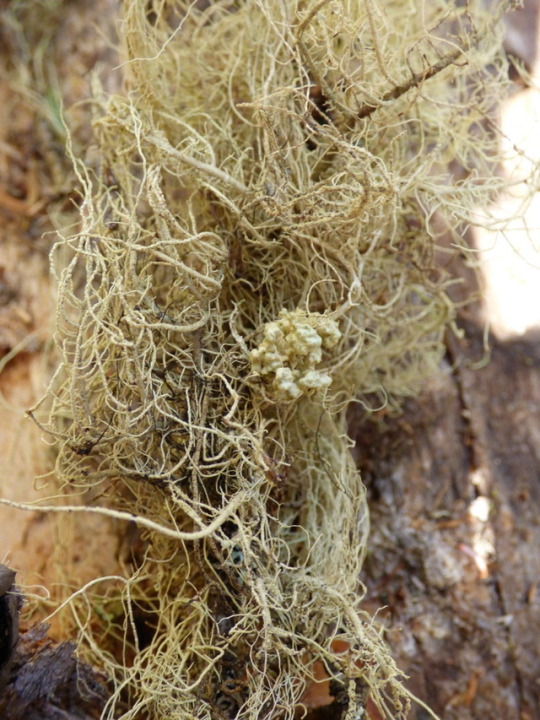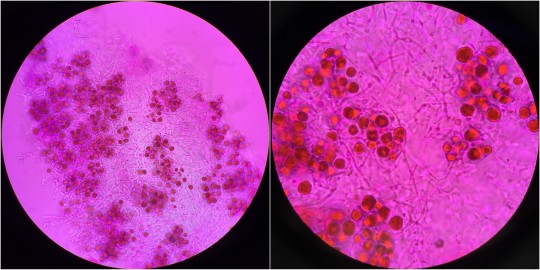#tremella everniae
Photo

Preface
Yes, this post is long enough to require a preface.
As promised, this is the extent of the world’s knowledge on Tremella everniae, gathered from the literature and an interview with Veera Tuovinen, a grad student who does research on this species. This was originally written as an assignment for my Fungi course where I had to make a wikipedia-style page about a species, and now I’m sharing it with y’all to celebrate getting an A+ in the course AND a job working with my prof this summer!
Tremella everniae
Binomial name: Tremella everniae Deiderich
English name: none
Classification
Phylum: Basidiomycota
Class: Tremellomycetes
Order: Tremellales
Family: Tremellaceae
Genus: Tremella
Species: Tremella everniae
Description
Tremella everniae is a lichenicolous Basidiomycete fungus thought to be parasitic on the Ascomycete lichens Evernia mesomorpha, Evernia prunastri, and Evernia esorediosa. The only structure currently described is its fruiting body or basidioma, which is a popcorn-like gall formed on the host. The basidioma is 3-15mm in diameter and is initially the same grey-green colour as the host, then develops a brownish hymenium at maturity. The interior of the basidioma appears white and fluffy, and contains hyphae of both T. everniae and the host fungus, algal cells, and basidia and basidiospores of T. everniae.
Tremella everniae is a heterobasidiomycete. Heterobasidiomycetes are a polyphyletic group characterized by basidiospores which can germinate by means of secondary spores, basidia that are are often septate, and being saprophytes or parasites on other fungi or on plants. The genus Tremella is not a monophyletic group, so T. everniae has little in common with jelly fungi also included in this genus.
Life Cycle
Tremella species are generally all dimorphic, having a hyphal teleomorph and a yeast anamorph. Although only the fruiting body of the hyphal phase has been described in T. everniae, it is assumed that this species is dimorphic and has a yeast phase as well. It is hypothesized that the yeast phase may be found in the cortex of the host lichen.
There are two phases of the dimorphic life cycle, haploid yeast and dikaryotic mycelium. The yeast cells conjugate to form the mycelium, which then forms the fruiting body, which produces basidiospores that give rise to more yeast cells. The mycelium may also produce conidia which give rise to yeast cells.
Ecology and Distribution
Tremella everniae can be found on the lichen Evernia mesomorpha. It has also been found on the lichens Evernia prunastri in Europe and Evernia esorediosa in northern Asia.
The exact distribution of T. everniae is unknown but assumed to be the same as that of its host lichens. E. mesomorpha is found over conifers in open boreal forests at lower elevations. E. prunastri is found over coniferous and deciduous trees and shrubs in sheltered, humid forests at lower elevations. Both host lichens are incompletely circumpolar.
In Alberta, T. everniae can be found in the boreal forest.
Parasitism
Tremella everniae is thought to be mycoparasitic on the fungus in its host lichens. Almost all Tremella species are mycoparasites, and so it is assumed that the same is true of T. everniae. However, because the genus Tremella is polyphyletic, its species may bear little resemblance to each other. T. everniae has lots of haustoria, the structures known to be used by parasitic fungi to extract resources from their hosts, however the presence of haustoria is not necessarily evidence of mycoparasitism. It is unknown whether the haustoria of T. everniae actually penetrate the host cells. Additionally, some assume that the presence of galls is automatically an indication of disease, however this has not been proven.
Future Research
Very little is known about Tremella everniae! Future research could focus on locating the yeast phase, and determining the exact nature of the relationship between T. everniae and its host lichen. It would also be valuable to determine the phylogenetic relationships within the polyphyletic genus Tremella in order to make valid comparisons between species.
Gallery

Left: Cross section of Tremella everniae fruiting body stained with phloxine and viewed at 40x magnification. Note the algal cells (large red circles) and fungal hyphae (squiggly lines). Right: Cross section of Tremella everniae fruiting body stained with phloxine and viewed at 100x magnification.
References
von Brackel, W. and D. Puntillo. 2016. New records of lichenicolous fungi from Calabria (southern Italy), including a first checklist. Herzogia 29(2):277-306.
Diederich, P. The Lichenicolous Heterobasidiomycetes. Bibliotheca Lichenologica 61.
Goward, T. 1999. The Lichens of British Columbia: Illustrated Keys, Part 2 - Fruticose Species. Crown Publications, Victoria, British Columbia, Canada.
Liu, X.-Z., Q.-M. Wang, M. Göker, M. Groenewald, A. V. Kachalkin, H. T. Lumbsch, A. M. Millanes, M. Wedin, A. M. Yurkov, T. Boekhout, and F.-Y. Bai. 2016. Towards an integrated phylogenetic classification of the Tremellomycetes. Studies in Mycology 81:85-147.
Millanes, A. M., P. Diederich, S. Ekman, and M. Wedin. 2011. Phylogeny and character evolution in the jelly fungi (Tremellomycetes, Basidiomycota, Fungi). Molecular Phylogenetics and Evolution 61:12-28.
Zhurbenko, M. P. and S. E. Vershinina. 2014. Opegrapha bryoriae sp. nov. and other lichenicolous fungi from Asian Russia. Herzogia 27(1):93-109.
Zugmaier, W., R. Bauer, and F. Oberwinkler. 1994. Mycoparasitism of some Tremella species. Mycologia 86(1):49-56.
#fungi#fungus#lichen#lichens#mycology#science#tremella#tremella everniae#evernia#evernia mesomorpha#evernia prunastri#evernia esorediosa#lichenicolous fungus#mycoparasitism#lichenology#not plants
29 notes
·
View notes
Text
lichen people:
Can anyone point me in the direction of some lichen resources? specifically on Tremella everniae and/or Evernia mesomorpha.
@botanyshitposts sorry to single you out but you seem to know things about lichens
#not plants#lichen#lichens#mycology#lichenology#tremella#tremella everniae#evernia#evernia mesomorpha
36 notes
·
View notes